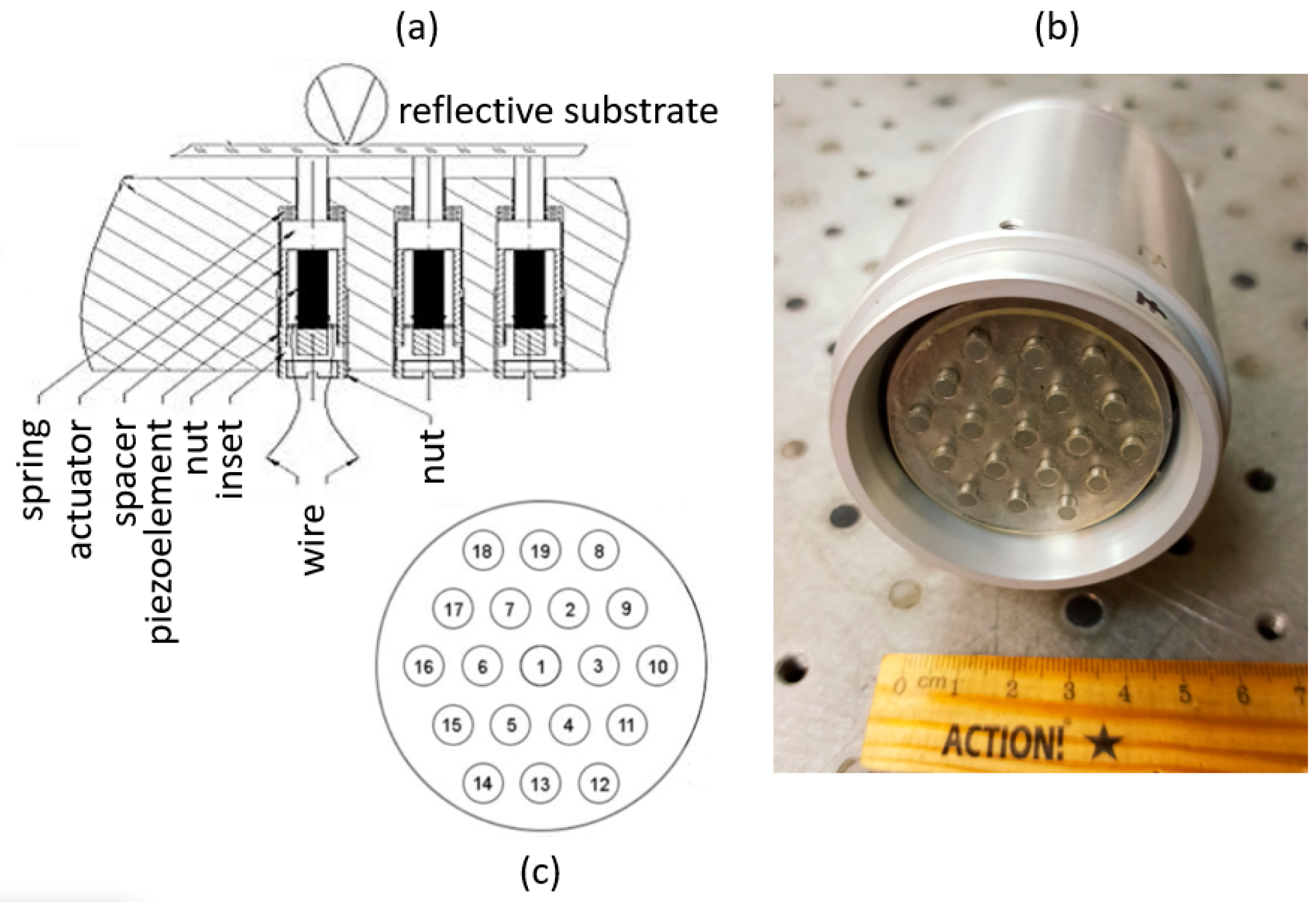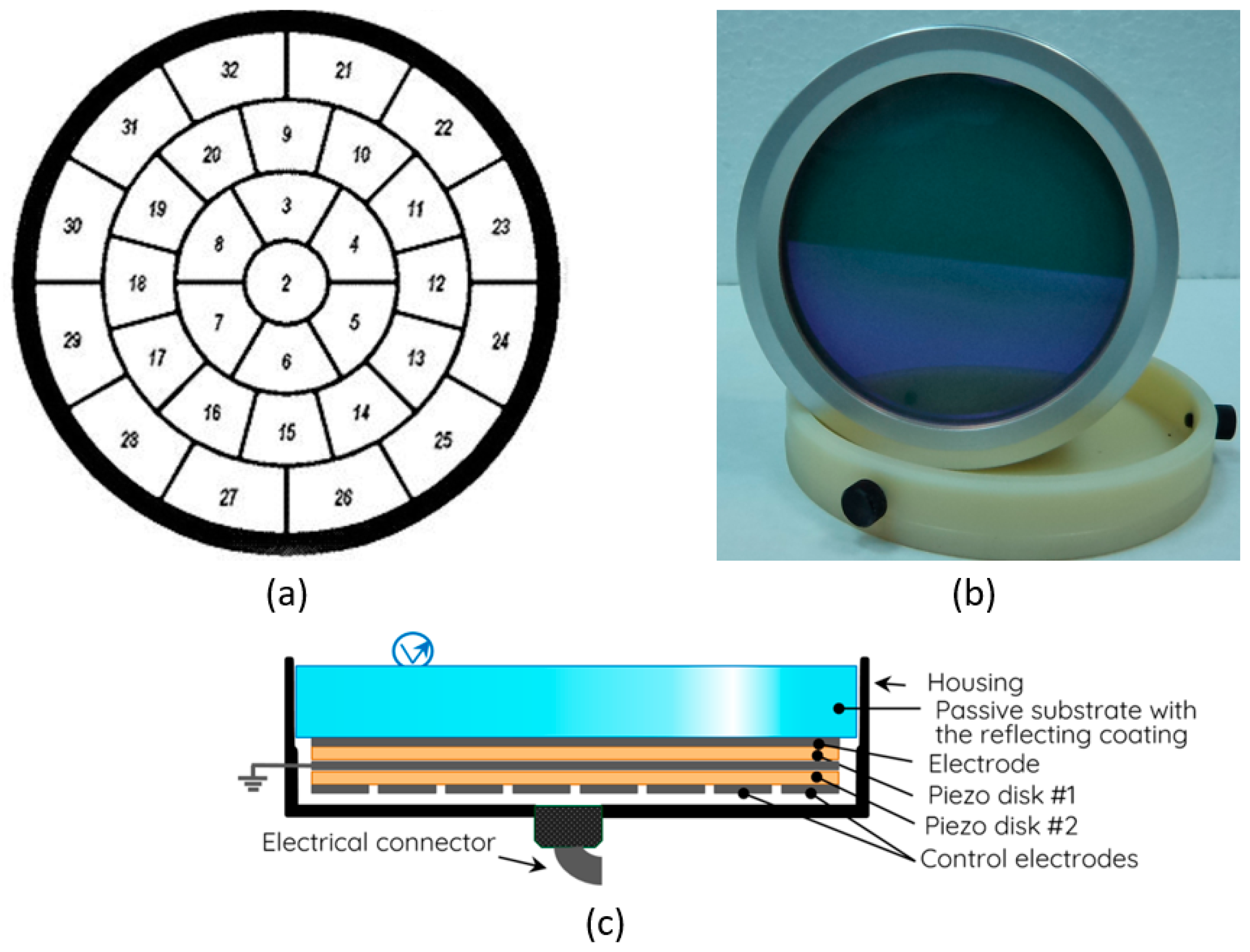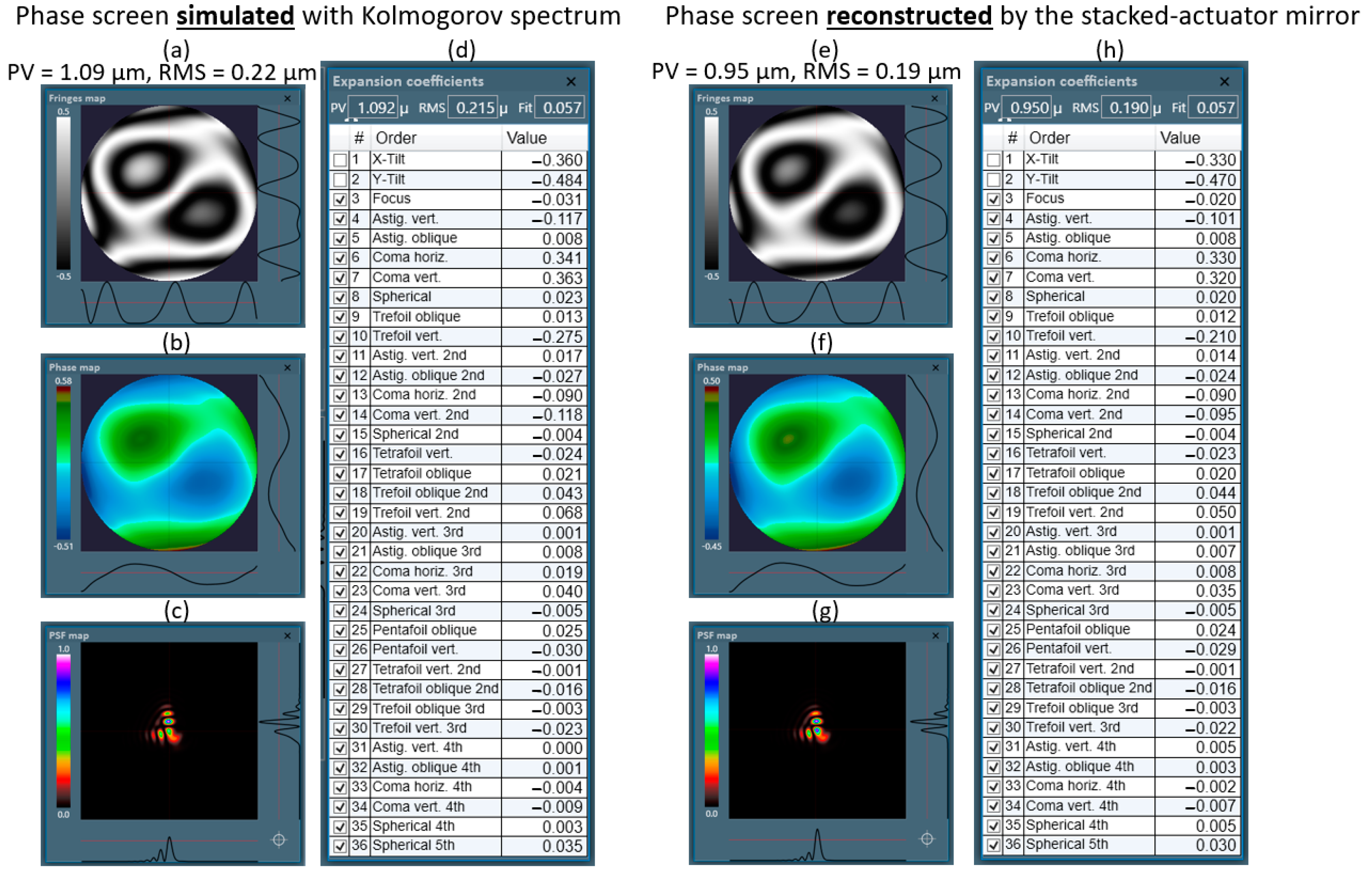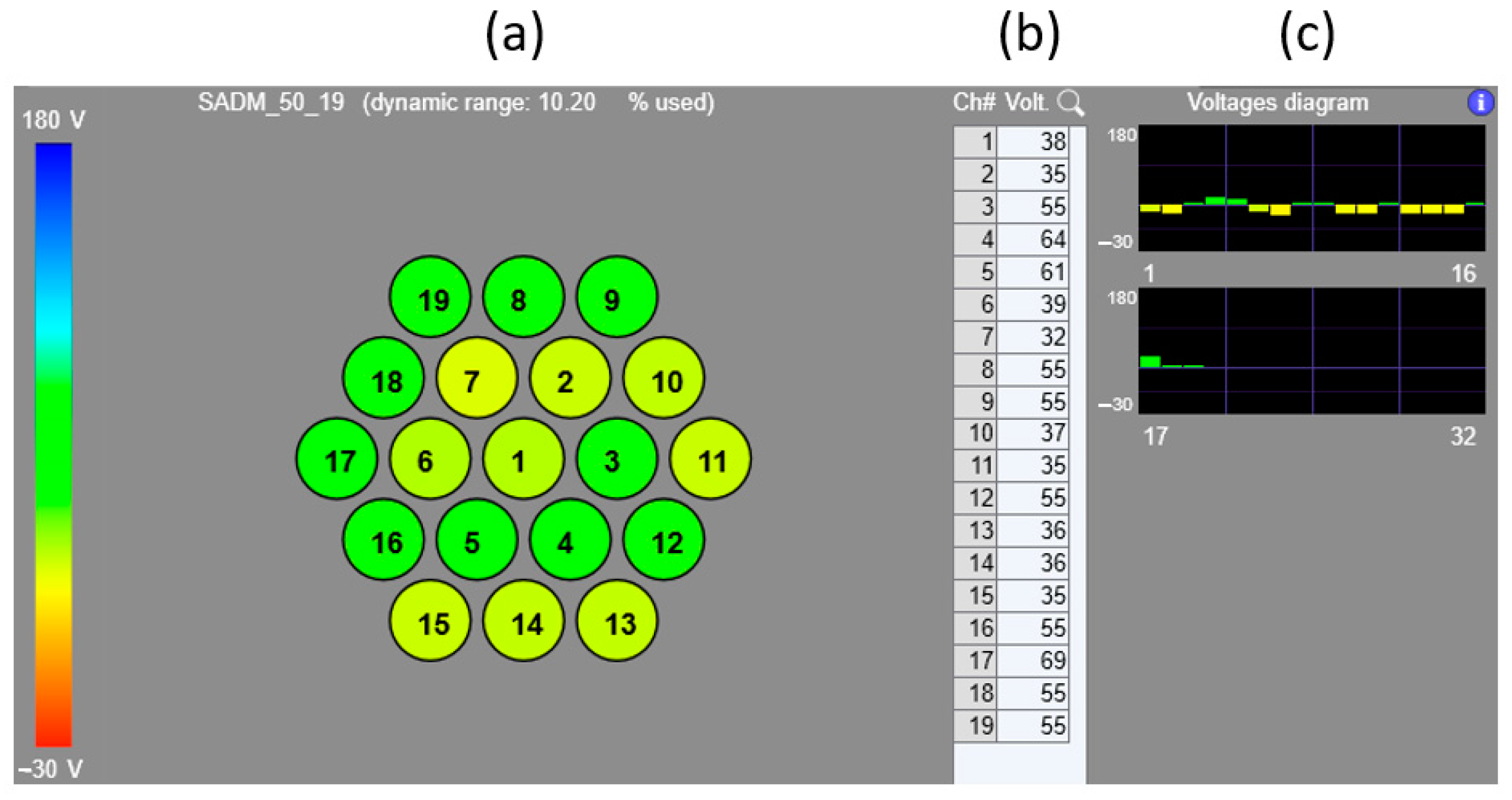Atmospheric Turbulence with Kolmogorov Spectra: Software Simulation, Real-Time Reconstruction and Compensation by Means of Adaptive Optical System with Bimorph and Stacked-Actuator Deformable Mirrors
Abstract
:1. Introduction
2. Materials and Methods
2.1. Experimental Setup
2.2. Stacked-Actuator Deformable Mirror
2.3. Bimorph Deformable Mirror
2.4. Shack–Hartmann Wavefront Sensor
2.5. Algorithm of Phase Screens Simulation
- As we had the Zernike approximation of the simulated phase screen, we could calculate the values of the wavefront derivatives in each sub-aperture of the wavefront sensor.
- Knowing the values of the wavefront derivatives, we could calculate the displacements of the focal spots corresponding to these derivatives.
- Thus, knowing the focal spot shifts associated with the mirror response functions and the focal spot displacements corresponding to the wavefront to be reproduced, we could solve the overdetermined system of linear equations using the least squares method and calculate the vector of voltages that had to be applied to the mirror actuators.
2.6. Algorithm of Phase Screen Compensation
- The wavefront of the laser beam reflected from the stacked-actuator and bimorph mirrors was analyzed on the Shack–Hartmann wavefront sensor.
- Having, on the one hand, the matrix of displacements of the focal spots on the Shack–Hartmann sensor , corresponding to the wavefront of the reconstructed phase screen, and, on the other hand, the matrix of values of the bimorph mirror response functions RF, also consisting of the focal spots shifts, we obtained an overdetermined system of linear equations for unknown coefficients, which were the values of the voltages at the mirror electrodes. To solve this system of equations, the least squares method was used.
- The calculated voltages were applied to the electrodes of the bimorph mirror.
- The residual wavefront was measured by means of the Shack–Hartmann sensor.
3. Results and Discussion
- Calculation of the control voltages to be applied to the actuators of the stacked-actuator deformable mirror [73].
- Reconstruction of the simulated phase screens using the stacked-actuator mirror.
- Measurement of the introduced wavefront distortions using the Shack–Hartmann wavefront sensor.
- Calculation of the control voltages to be applied to the electrodes of the bimorph deformable mirror in order to compensate for the wavefront distortions.
- Compensation of the reconstructed phase screens by the bimorph mirror.
4. Conclusions
Author Contributions
Funding
Institutional Review Board Statement
Informed Consent Statement
Data Availability Statement
Acknowledgments
Conflicts of Interest
Correction Statement
References
- Tatarsky, V.I. Waves Propagation in Turbulent Atmosphere; Nauka: Moscow, Russia, 1967. [Google Scholar]
- Andrews, L.C.; Phillips, R.L. Laser Beam Propagation Through Random Media, 2nd ed.; SPIE Press: Bellingham, WA, USA, 2005. [Google Scholar]
- Huang, Q.; Liu, D.; Chen, Y.; Wang, Y.; Tan, J.; Chen, W.; Liu, J.; Zhu, N. Secure free-space optical communication system based on data fragmentation multipath transmission technology. Opt. Express 2018, 26, 13536–13542. [Google Scholar] [CrossRef] [PubMed]
- Nafria, V.; Han, X.; Djordjevic, I. Improving free-space optical communication with adaptive optics for higher order modulation. In Proceedings of the Optics and Photonics for Information Processing XIV, Online, CA, USA, 24 August–4 September 2020. [Google Scholar]
- Vorontsov, M.; Weyrauch, T.; Carhart, G.; Beresnev, L. Adaptive Optics for Free Space Laser Communications. In Lasers, Sources and Related Photonic Devices, OSA Technical Digest Series (CD); Optica Publishing Group: Washington, DC, USA, 2010; p. LSMA1. [Google Scholar]
- Weyrauch, T.; Vorontsov, M. Free-space laser communications with adaptive optics: Atmospheric compensation experiments. J. Optic. Comm. Rep. 2004, 1, 355–379. [Google Scholar] [CrossRef]
- Lema, G. Free space optics communication system design using iterative optimization. J. Opt. Commun. 2020, 000010151520200007. [Google Scholar] [CrossRef]
- Zhang, Y.; Wang, Y.; Deng, Y.; Du, A.; Liu, J. Design of a Free Space Optical Communication System for an Unmanned Aerial Vehicle Command and Control Link. Photonics 2021, 8, 163. [Google Scholar] [CrossRef]
- Majumdar, A. Fundamentals of Free-Space Optical (FSO) Communication System. In Advanced Free Space Optics (FSO); Series in Optical Sciences; Springer: New York, NY, USA, 2015; Volume 186. [Google Scholar]
- Lu, M.; Bagheri, M.; James, A.P.; Phung, T. Wireless Charging Techniques for UAVs: A Review, Reconceptualization, and Extension. IEEE Access 2018, 6, 29865–29884. [Google Scholar] [CrossRef]
- Geoffrey, A.; Landis, H. Laser beamed power—Satellite demonstration applications. In Proceedings of the 43rd International Astronautical Congress, Washington, DC, USA, 28 August–5 September 1992. [Google Scholar]
- Vorontsov, M.; Weyrauch, T.; Carhart, G. Lasers, Sources and Related Photonic Devices; OSA Technical Digest Series (CD); Optica Publishing Group: San Diego, USA, 2010; p. LSMA1. [Google Scholar]
- Galaktionov, I.; Kudryashov, A.; Sheldakova, J.; Nikitin, A. Laser beam focusing through the scattering medium by means of adaptive optics. In Proceedings of the Adaptive Optics and Wavefront Control for Biological Systems III, San Francisco, CA, USA, 28 January–2 February 2017. [Google Scholar]
- Wang, R.; Wang, Y.; Jin, C.; Yin, X.; Wang, S.; Yang, C.; Cao, Z.; Mu, Q.; Gao, S.; Xuan, L. Demonstration of horizontal free-space laser communication with the effect of the bandwidth of adaptive optics system. Opt. Commun. 2018, 431, 167–173. [Google Scholar] [CrossRef]
- Chittoor, P.K.; Chokkalingam, B.; Mihet-Popa, L. A Review on UAV Wireless Charging: Fundamentals, Applications, Charging Techniques and Standards. IEEE Access 2021, 9, 69235–69266. [Google Scholar] [CrossRef]
- Wang, C.; Ma, Z. Design of wireless power transfer device for UAV. In Proceedings of the 2016 IEEE International Conference on Mechatronics and Automation, Harbin, China, 7–10 August 2016; pp. 2449–2454. [Google Scholar]
- Bennet, F.; Conan, R.; D’Orgeville, C.; Dawson, M.; Paulin, N.; Price, I.; Rigaut, F.; Ritchie, I.; Smith, C.; Uhlendorf, K. Adaptive optics for laser space debris removal. In Proceedings of the Adaptive Optics Systems III, Amsterdam, The Netherlands, 1–6 July 2012. [Google Scholar]
- Phipps, C.R.; Baker, K.L.; Libby, S.B.; Liedahl, D.A.; Olivier, S.S.; Pleasance, L.D.; Rubenchik, A.; Trebes, J.E.; George, E.V.; Marcovici, B.; et al. Removing orbital debris with lasers. Adv. Space Res. 2012, 49, 1283–1300. [Google Scholar] [CrossRef]
- Shen, S.; Jin, X.; Hao, C. Cleaning space debris with a space-based laser system. Chin. J. Aeronaut. 2014, 27, 805–811. [Google Scholar] [CrossRef]
- Sheldakova, J.; Galaktionov, I.; Nikitin, A.; Rukosuev, A.; Kudryashov, A. LC phase modulator vs deformable mirror for laser beam shaping: What is better? In Proceedings of the Laser Beam Shaping XVIII, San Diego, CA, USA, 19–23 August 2018; Volume 10744, pp. 156–162. [Google Scholar]
- Galaktionov, I.; Nikitin, A.; Sheldakova, J.; Toporovsky, V.; Kudryashov, A. Focusing of a Laser Beam Passed through a Moderately Scattering Medium Using Phase-Only Spatial Light Modulator. Photonics 2022, 9, 296. [Google Scholar] [CrossRef]
- Galaktionov, I.; Kudryashov, A.; Sheldakova, J.; Nikitin, A. The use of modified hill-climbing algorithm for laser beam focusing through the turbid medium. In Proceedings of the Laser Resonators, Microresonators, and Beam Control XIX, San Francisco, CA, USA, 28 January–2 February 2017. [Google Scholar]
- Barros, R.; Keary, S. Experimental setup for investigation of laser beam propagation along horizontal urban path. Proc. SPIE 2014, 9242, 396–404. [Google Scholar]
- Mata-Calvo, R. Transmitter diversity verification on Artemis geostationary satellite. In Proceedings of the Free-Space Laser Communication and Atmospheric Propagation XXVI, San Francisco, CA, USA, 1–6 February 2014. [Google Scholar]
- Mosavi, N.; Marks, B.; Boone, B.; Menyuk, C. Optical beam spreading in the presence of both atmospheric turbulence and quartic aberration. In Proceedings of the Free-Space Laser Communication and Atmospheric Propagation XXVI, San Francisco, CA, USA, 1–6 February 2014. [Google Scholar]
- Murty, S.S.R. Laser beam propagation in atmospheric turbulence. Proc. Indian Acad. Sci. 1979, 2, 179–195. [Google Scholar] [CrossRef]
- Kwiecień, J. The effects of atmospheric turbulence on laser beam propagation in a closed space—An analytic and experimental approach. Opt. Commun. 2019, 433, 200–208. [Google Scholar] [CrossRef]
- Searles, S.; Hart, G.; Dowling, J.; Hanley, S. Laser beam propagation in turbulent conditions. Appl. Opt. 1991, 30, 401–406. [Google Scholar] [CrossRef]
- Gareth, D.; Naven, C. Experimental analysis of a laser beam propagating in angular turbulence. Open Phys. 2022, 20, 402–415. [Google Scholar]
- Summerer, L.; Purcell, O. Concepts for wireless energy transmission via laser. J. Br. Interplanet. Soc. 2005, 58, 1–10. [Google Scholar]
- Fahey, T.; Islam, M.; Gardi, A.; Sabatini, R. Laser Beam Atmospheric Propagation Modelling for Aerospace LIDAR Applications. Atmosphere 2021, 12, 918. [Google Scholar] [CrossRef]
- Zohuri, B. Atmospheric Propagation of High-Energy Laser Beams. In Directed Energy Weapons; Springer: Cham, Switzerland, 2016. [Google Scholar]
- Shuto, Y. Effect of Water and Aerosols Absorption on Laser Beam Propagation in Moist Atmosphere at Eye-Safe Wavelength of 1.57 µm. J. Electr. Electron. Eng. 2023, 11, 15–22. [Google Scholar]
- Rosen, L.; Ipser, J. High Energy Laser Beam Scattering by Atmospheric Aerosol Aureoles. In Proceedings of the Nonlinear Optical Beam Manipulation and High Energy Beam Propagation through the Atmosphere, Los Angeles, CA, USA, 5–20 January 1989. [Google Scholar]
- Oosterwijk, A.; Heikamp, S.; Manders-Groot, A.; Lex, A.; Eijk, J. Comparison of modelled atmospheric aerosol content and its influence on high-energy laser propagation. In Proceedings of the Laser Communication and Propagation through the Atmosphere and Oceans VIII, San Diego, CA, USA, 11–15 August 2019. [Google Scholar]
- Kudryashov, A.; Rukosuev, A.; Samarkin, V.; Galaktionov, I.; Kopylov, E. Fast adaptive optical system for 1.5 km horizontal beam propagation. In Proceedings of the Unconventional and Indirect Imaging, Image Reconstruction, and Wavefront Sensing 2018, San Diego, CA, USA, 19–23 August 2018. [Google Scholar]
- Soloviev, A.; Kotov, A.; Perevalov, S.; Esyunin, M.; Starodubtsev, M.; Alexandrov, A.; Galaktionov, I.; Samarkin, V.; Kudryashov, A.; Ginzburg, V.; et al. Adaptive system for wavefront correction of the PEARL laser facility. Quantum Electron. 2022, 50, 1115–1122. [Google Scholar] [CrossRef]
- Samarkin, V.; Alexandrov, A.; Galaktionov, I.; Kudryashov, A.; Nikitin, A.; Rukosuev, A.; Toporovsky, V.; Sheldakova, Y. Large-aperture adaptive optical system for correcting wavefront distortions of a petawatt Ti:sapphire laser beam. Quantum Electron. 2022, 52, 187–194. [Google Scholar] [CrossRef]
- Buck, A.L. Effects of the Atmosphere on Laser Beam Propagation. Appl. Opt. 1967, 6, 703–708. [Google Scholar] [CrossRef] [PubMed]
- Galaktionov, I.; Kudryashov, A.; Sheldakova, J.; Nikitin, A.; Samarkin, V. Laser beam focusing through the atmosphere aerosol. In Proceedings of the Unconventional and Indirect Imaging, Image Reconstruction, and Wavefront Sensing 2017, San Diego, CA, USA, 6–10 August 2017; Volume 10410, pp. 152–165. [Google Scholar]
- Lylova, A.; Kudryashov, A.; Sheldakova, J.; Borsoni, G. The real-time atmospheric turbulence modeling and compensation with the use of adaptive optics. In Proceedings of the Optics in Atmospheric Propagation and Adaptive Systems XVIII, Toulouse, France, 21–24 September 2015. [Google Scholar]
- Gonglewski, J.; Highland, R.; Dayton, D.; Sandven, S.; Rogers, S.; Browne, S. ADONIS: Daylight Imaging through Atmospheric Turbulence. In Proceedings of the Digital Image Recovery and Synthesis III, Denver, CO, USA, 4–9 August 1996. [Google Scholar]
- Marchi, G.; Weiß, R. Evaluations and Progress in the Development of an Adaptive Optics System for Ground Object Observation. In Proceedings of the Optics in Atmospheric Propagation and Adaptive Systems X, Florence, Italy, 17–20 September 2007. [Google Scholar]
- Marchi, G.; Scheifling, C. Adaptive optics concepts and systems for multipurpose applications at near horizontal line of sight: Developments and results. In Proceedings of the Optics in Atmospheric Propagation and Adaptive Systems XII, Berlin, Germany, 31 August–3 September 2009. [Google Scholar]
- Segel, M.; Gladysz, S.; Stein, K. Optimal modal compensation in gradient-based wavefront sensorless adaptive optics. In Proceedings of the Laser Communication and Propagation through the Atmosphere and Oceans VIII, San Diego, CA, USA, 11–15 August 2019. [Google Scholar]
- Segel, M.; Zepp, A.; Anzuola, E.; Gladysz, S.; Stein, K. Optimization of wavefront-sensorless adaptive optics for horizontal laser beam propagation in a realistic turbulence environment. In Proceedings of the Laser Communication and Propagation through the Atmosphere and Oceans VI, San Diego, CA, USA, 6–10 August 2017. [Google Scholar]
- Gonglewski, J.; Dayton, D. Least squares blind deconvolution of air to ground imaging. In Proceedings of the Optics in Atmospheric Propagation and Adaptive Systems VIII, Bruges, Belgium, 19–22 September 2005. [Google Scholar]
- Mackey, R.; Dainty, C. Adaptive optics correction over a 3km near horizontal path. In Proceedings of the Optics in Atmospheric Propagation and Adaptive Systems XI, Cardiff, UK, 15–18 September 2008. [Google Scholar]
- Sheldakova, J.; Toporovsky, V.; Galaktionov, I.; Nikitin, A.; Rukosuev, A.; Samarkin, V.; Kudryashov, A. Flat-top beam formation with miniature bimorph deformable mirror. In Proceedings of the Laser Beam Shaping XX, Online, CA, USA, 24 August–4 September 2020. [Google Scholar]
- Samarkin, V.; Alexandrov, A.; Galaktionov, I.; Kudryashov, A.; Nikitin, A.; Rukosuev, A.; Toporovsky, V.; Sheldakova, J. Wide-Aperture Bimorph Deformable Mirror for Beam Focusing in 4.2 PW Ti:Sa Laser. Appl. Sci. 2022, 12, 1144. [Google Scholar] [CrossRef]
- Galaktionov, I.; Nikitin, A.; Samarkin, V.; Sheldakova, J.; Kudryashov, A. Laser beam focusing through the scattering medium-low order aberration correction approach. In Proceedings of the Unconventional and Indirect Imaging, Image Reconstruction, and Wavefront Sensing 2018, San Diego, CA, USA, 19–23 August 2018. [Google Scholar]
- Galaktionov, I.; Kudryashov, A.; Sheldakova, J.; Nikitin, A. Laser beam focusing through the dense multiple scattering suspension using bimorph mirror. In Proceedings of the Adaptive Optics and Wavefront Control for Biological Systems V, San Francisco, CA, USA, 20 February 2019; Volume 10886, p. 1088619. [Google Scholar]
- Platt, B.; Shack, R.J. History and principles of Shack-Hartmann wavefront sensing. Refr. Surg. 2001, 17, 15. [Google Scholar] [CrossRef]
- Liang, J.; Grimm, B.; Goelz, S.; Bille, J.F. Objective measurement of the wave aberrations of the human eye with the use of a Hartmann-Shack wave-front sensor. J. Opt. Soc. Am. A 1994, 11, 1949. [Google Scholar] [CrossRef]
- Lane, R.G. Wave-front reconstruction using a Shack–Hartmann sensor. Appl. Opt. 1992, 31, 6902. [Google Scholar] [CrossRef]
- Primot, J. Theoretical description of Shack–Hartmann wave-front sensor. Opt. Commun. 2003, 222, 81–92. [Google Scholar] [CrossRef]
- Konnik, M.; Doná, J. Waffle mode mitigation in adaptive optics systems: A constrained Receding Horizon Control approach. In Proceedings of the American Control Conference, Washington, DC, USA, 17–19 June 2013; pp. 3390–3396. [Google Scholar]
- Mauch, S.; Reger, J. Real-Time Spot Detection and Ordering for a Shack–Hartmann Wavefront Sensor with a Low-Cost FPGA. Proc. IEEE Trans. Instrum. Meas. 2014, 63, 2379–2386. [Google Scholar] [CrossRef]
- Nikitin, A.; Galaktionov, I.; Sheldakova, J.; Kudryashov, A.; Baryshnikov, N.; Denisov, D.; Karasik, V.; Sakharov, A. Absolute calibration of a Shack-Hartmann wavefront sensor for measurements of wavefronts. In Proceedings of the Photonic Instrumentation Engineering VI, San Francisco, CA, USA, 2–7 February 2019. [Google Scholar]
- Galaktionov, I.; Sheldakova, J.; Nikitin, A.; Toporovsky, V.; Kudryashov, A. A Hybrid Model for Analysis of Laser Beam Distortions Using Monte Carlo and Shack–Hartmann Techniques: Numerical Study and Experimental Results. Algorithms 2023, 16, 337. [Google Scholar] [CrossRef]
- Galaktionov, I.; Kudryashov, A.; Sheldakova, J.; Byalko, A.; Borsoni, G. Laser beam propagation and wavefront correction in turbid media. In Proceedings of the Unconventional Imaging and Wavefront Sensing 2015, San Diego, CA, USA, 9–13 August 2015. [Google Scholar]
- Galaktionov, I.; Nikitin, A.; Sheldakova, J.; Kudryashov, A. B-spline approximation of a wavefront measured by Shack-Hartmann sensor. In Proceedings of the Laser Beam Shaping XXI, San Diego, CA, USA, 1–5 August 2021. [Google Scholar]
- Malacara-Hernandez, D. Wavefront fitting with discrete orthogonal polynomials in a unit radius circle. Opt. Eng. 1990, 29, 672–675. [Google Scholar] [CrossRef]
- Wyant, J.C.; Creath, K. Basic wavefront aberration theory for optical metrology. In Applied Optics and Optical Engineering; Academic Press: Cambridge, MA, USA, 1992; pp. 28–39. [Google Scholar]
- Genberg, V.; Michels, G.; Doyle, K. Orthogonality of Zernike polynomials. Proc. SPIE 2002, 4771, 276–287. [Google Scholar]
- Lakshminarayanan, V.; Fleck, A. Zernike polynomials: A guide. J. Mod. Opt. 2011, 58, 545–561. [Google Scholar] [CrossRef]
- Linnik, J.V. Least Square Error Method and the Basics of Mathematical-Statistical Theory, 2nd ed.; Mir: Moscow, Russia, 1962. [Google Scholar]
- Kandidov, V.; Shlenov, A. Atmospheric Turbulence Simulation. Grid Representation. Technical Summary; International Laser Center: Moscow, Russia, 1995. [Google Scholar]
- Vorontsov, M.; Shmalhausen, V. Principles of Adaptive Optics; Nauka: Moscow, Russia, 1985. [Google Scholar]
- Dudorov, V.; Kolosov, V.; Filimonov, G. Algorithm for formation of an infinite random turbulent screen. In Proceedings of the Twelfth Joint International Symposium on Atmospheric and Ocean Optics/Atmospheric Physics, Tomsk, Russia, 27–30 June 2005. [Google Scholar]
- Lane, R.G.; Glindemann, A.; Dainty, J.C. Simulation of Kolmogorov phase screen. Waves Random Media 1992, 2, 209–224. [Google Scholar] [CrossRef]
- Burger, L.; Litvin, I.; Forbes, A. Simulating atmospheric turbulence using a phase-only spatial light modulator. South Afr. J. Sci. 2008, 104, 129–137. [Google Scholar]
- Laslandes, M.; Patterson, K.; Pellegrino, S. Optimized actuators for ultrathin deformable primary mirrors. Appl. Opt. 2015, 54, 1559. [Google Scholar] [CrossRef] [PubMed]
- Liu, D.; Wang, Z.; Liu, J.; Tan, J.; Yu, L.; Mei, H.; Zhou, Y.; Zhu, N. Performance analysis of 1-km free-space optical communication system over real atmospheric turbulence channels. Opt. Eng. 2017, 56, 106111. [Google Scholar] [CrossRef]
- Li, M.; Cvijetic, M. Coherent free space optics communications over the maritime atmosphere with use of adaptive optics for beam wavefront correction. Appl. Opt. 2015, 54, 1453–1462. [Google Scholar] [CrossRef]
- Wright, M.W.; Morris, J.F.; Kovalik, J.M.; Andrews, K.S.; Abrahamson, M.J.; Biswas, A. Adaptive optics correction into single mode fiber for a low Earth orbiting space to ground optical communication link using the OPALS downlink. Opt. Express 2015, 23, 33705–33712. [Google Scholar] [CrossRef] [PubMed]
- Thompson, C.A.; Kartz, M.W.; Flath, L.M.; Wilks, S.C.; Young, R.A.; Johnson, G.W.; Ruggiero, A.J. Free space optical communications utilizing MEMS adaptive optics correction. In Proceedings of the Free-Space Laser Communication and Laser Imaging II, Seattle, WA, USA, 7–11 July 2002. [Google Scholar]
- Majumdar, A.K.; Eaton, F.D.; Jensen, M.L.; Kyrazis, D.T.; Schumm, B.; Dierking, M.P.; Shoemake, M.A.; Dexheimer, D.; Ricklin, J.C. Atmospheric Turbulence Measurements over Desert site using groundbased instruments, kite/tethered-blimp platform and aircraft relevant to optical communications and imaging systems: Preliminary Results. In Proceedings of the Free-Space Laser Communications VI, San Diego, CA, USA, 13–17 August 2006. [Google Scholar]
- Cornelissen, S.; Hartzell, A.; Stewart, J.; Bifano, T.; Bierden, T. MEMS Deformable Mirrors for Astronomical Adaptive Optics. In Proceedings of the Adaptive Optics Systems II, San Diego, CA, USA, 27 June–2 July 2010. [Google Scholar]








| Parameter | Value |
|---|---|
| Substrate aperture | 40 mm |
| Clear aperture | 35 mm |
| Substrate material | glass |
| No. of control actuators | 19 |
| Type of actuators | PZT |
| Actuators geometry | Hexagonal |
| Maximum input voltage | −30…+130 V |
| Parameter | Value |
|---|---|
| Substrate aperture | 35 mm |
| Clear aperture | 30 mm |
| Substrate material | glass |
| No. of PZT | 2 |
| No. of control electrodes | 32 |
| Type of actuators | PZT discs |
| Actuators geometry | sectorial |
| Maximum input voltage | −200…+300 V |
Disclaimer/Publisher’s Note: The statements, opinions and data contained in all publications are solely those of the individual author(s) and contributor(s) and not of MDPI and/or the editor(s). MDPI and/or the editor(s) disclaim responsibility for any injury to people or property resulting from any ideas, methods, instructions or products referred to in the content. |
© 2023 by the authors. Licensee MDPI, Basel, Switzerland. This article is an open access article distributed under the terms and conditions of the Creative Commons Attribution (CC BY) license (https://creativecommons.org/licenses/by/4.0/).
Share and Cite
Galaktionov, I.; Sheldakova, J.; Samarkin, V.; Toporovsky, V.; Kudryashov, A. Atmospheric Turbulence with Kolmogorov Spectra: Software Simulation, Real-Time Reconstruction and Compensation by Means of Adaptive Optical System with Bimorph and Stacked-Actuator Deformable Mirrors. Photonics 2023, 10, 1147. https://doi.org/10.3390/photonics10101147
Galaktionov I, Sheldakova J, Samarkin V, Toporovsky V, Kudryashov A. Atmospheric Turbulence with Kolmogorov Spectra: Software Simulation, Real-Time Reconstruction and Compensation by Means of Adaptive Optical System with Bimorph and Stacked-Actuator Deformable Mirrors. Photonics. 2023; 10(10):1147. https://doi.org/10.3390/photonics10101147
Chicago/Turabian StyleGalaktionov, Ilya, Julia Sheldakova, Vadim Samarkin, Vladimir Toporovsky, and Alexis Kudryashov. 2023. "Atmospheric Turbulence with Kolmogorov Spectra: Software Simulation, Real-Time Reconstruction and Compensation by Means of Adaptive Optical System with Bimorph and Stacked-Actuator Deformable Mirrors" Photonics 10, no. 10: 1147. https://doi.org/10.3390/photonics10101147









